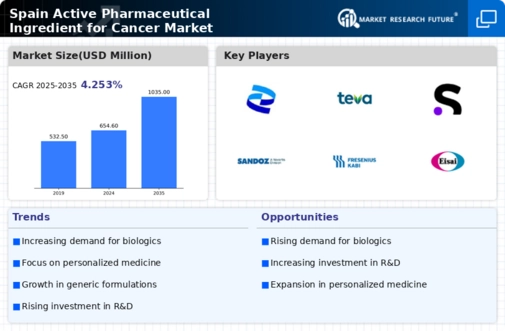The Spain Active Pharmaceutical Ingredient for Cancer Market has witnessed significant advancements in recent years, driven by increasing cancer prevalence, a growing geriatric population, and substantial investments in research and development by pharmaceutical companies.
This market is characterized by a competitive landscape where key players strive to innovate, enhance product portfolios, and develop cost-effective solutions for cancer treatment.
As the demand for effective and efficient cancer therapies rises, collaboration among industry stakeholders, including manufacturers, suppliers, and healthcare providers, is essential for sustaining growth and addressing healthcare challenges in this segment.
Additionally, regulatory frameworks and market dynamics continue to shape the competitive environment, necessitating agility, and strategic positioning by companies operating in this space.
Pfizer has established a strong presence in the Spain Active Pharmaceutical Ingredient for Cancer Market, leveraging its commitment to research and development to deliver innovative therapies.
The company's investment in advanced manufacturing technologies and quality assurance practices positions it as a leader in the production of active pharmaceutical ingredients designed specifically for oncology applications.
Pfizer’s strengths lie in its comprehensive understanding of cancer biology, coupled with its ability to respond rapidly to market needs, ensuring that it meets the demands of healthcare providers and patients.
The emphasis on collaboration with healthcare professionals further enhances Pfizer's capabilities, allowing it to tailor products that align with therapeutic advancements and patient care standards in Spain.
Teva Pharmaceutical Industries has made a significant impact in the Spain Active Pharmaceutical Ingredient for Cancer Market through its wide range of generic and specialty products, particularly aimed at oncology.
The company's strengths stem from its robust manufacturing capabilities, which facilitate the production of high-quality active pharmaceutical ingredients at competitive prices. Teva’s strategic focus on research-driven innovation enables it to introduce new generics and biosimilars that expand access to vital cancer treatments.
Teva has also engaged in strategic mergers and acquisitions, enhancing its market presence and diversifying its portfolio to include a broader spectrum of oncology-related products.
The emphasis on affordability combined with a commitment to high standards in production makes Teva a formidable player in the Spanish oncology market, catering to the needs of both patients and healthcare systems effectively.

























Leave a Comment